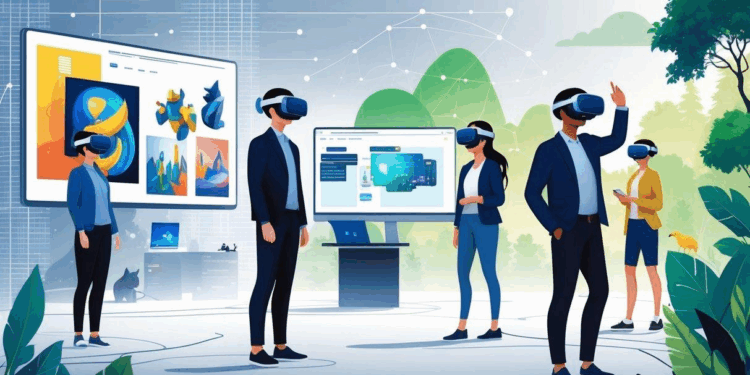Defining Niche Virtual Reality Platforms
Virtual reality platforms have become a lot more specialized lately. Instead of trying to be everything to everyone, these systems focus on unique needs—think healthcare, architecture, or even niche communities.
For instance, some VR environments are built specifically for medical training or language immersion. Others might cater to artists or engineers, offering tailored tools you just won’t find in mainstream systems.
They don’t try to cover every possible use. Instead, they zero in on delivering real value to smaller audiences with very specific goals.
Many of these platforms also connect directly with professional software. If you’re in design, your VR might plug right into CAD tools. In healthcare, it could sync with clinical training standards.
This kind of focus helps smaller VR platforms carve out their own space, even if they can’t match the size of mainstream giants.
Learn more about VR basics | Trends in VR industries
What Sets Niche VR Platforms Apart
Most people think of VR as gaming or general entertainment, but there’s a whole world of targeted platforms out there. These focus on deep, meaningful experiences for their users.
For example, a VR platform for surgeons might offer ultra-realistic simulations, while an education-focused one could track student progress in real time. It’s not about quantity—it’s about quality and relevance.
Integration with daily workflows is a big deal here. Whether it’s syncing with industry software or meeting specific regulatory standards, these platforms go the extra mile for their users.
Key Features and Technologies in Virtual Reality Platforms
Specialized VR platforms often mix cutting-edge tech with practical features. High-fidelity graphics are pretty much the norm for accurate simulations.
- Cloud VR streaming keeps hardware costs down
- AI-driven personalization adapts lessons or training to each user
- Spatial computing makes everything feel a bit more real
Surgeons can practice tricky procedures, and teachers can run classes that adapt to each student’s pace. It’s all about making the experience as close to the real thing as possible.
Hardware matters, too. Lightweight headsets and smart glasses let professionals use VR longer without getting tired. Cloud access means even small organizations can jump in without breaking the bank.
Target Audiences and Communities for Virtual Reality Platforms
These platforms are mostly built for professionals or passionate hobbyists. Doctors, architects, teachers—they’re all finding ways to use VR that’s actually relevant to their work.
Communities tend to form around shared interests. Language learners, for example, might meet in VR spaces to practice conversation, while industrial teams collaborate in virtual workrooms.
Accuracy, reliability, and usefulness matter way more than flashy graphics or casual fun. The best platforms solve real problems, whether that’s improving training or making remote teamwork easier.
Major Players and Emerging Innovators in Virtual Reality Platforms

Growth in virtual reality platforms is being driven by both big names and upstart innovators. Some companies focus on top-tier performance, while others are all about making VR portable and affordable.
It’s interesting to see how different strategies are shaping adoption, especially as more industries jump in beyond just gaming.
Oculus Quest and the Consumer Shift
Oculus, now under Meta, made a splash with the Quest series. Unlike older VR headsets that needed powerful PCs, the Quest works all on its own—no wires, no fuss.
This standalone approach opened doors for a lot more people. And if you want more power? You can still hook it up to a PC for those demanding experiences.
Developers love the growing user base, which means more apps, games, and even social platforms keep popping up. It’s hard to ignore Oculus Quest’s impact on the VR scene.
PlayStation VR and Console Integration
Sony’s PlayStation VR (PSVR) brought virtual reality platforms to the console crowd. By tying VR to the PlayStation ecosystem, Sony made it easy for gamers to try something new without leaving their comfort zone.
Exclusive titles and familiar franchises helped PSVR stand out. The newer PSVR2 ups the ante with better visuals and tracking, keeping VR fresh for PlayStation fans.
Standalone Headsets: Accessibility and Growth
Standalone VR headsets are changing the game for accessibility. They pack everything you need into one device—no extra hardware required.
The Quest line and newcomers like Pico make VR more portable and user-friendly. It’s not just about games, either; education and training apps are popping up everywhere.
Affordability and convenience are making standalone VR a go-to choice for a lot of people who might’ve hesitated before.
The Evolution of VR Gaming Experiences
Gaming in virtual reality has come a long way. What started as a niche experiment is now a mainstream playground for immersive visuals and interactive content.
Players want more than just pretty graphics—they’re after new ways to play, connect, and even create.
Immersive Gameplay and Interactivity in Virtual Reality Platforms
Modern VR headsets let you move, gesture, and interact with the world in ways traditional games can’t match. Picking up objects or dodging attacks feels a lot more natural now.
Environments react to your every move. Motion sensors track you in real time, making the virtual world feel surprisingly tangible.
Hardware upgrades—think higher refresh rates and better haptics—mean less motion sickness and longer play sessions. Sound design is a big deal, too; spatial audio makes everything more believable.
New Game Genres and Experiences
VR has given rise to genres that just wouldn’t work on a flat screen. Rhythm games like Beat Saber get your whole body moving, while simulations drop you into everything from race cars to kitchens.
Exploration games let you wander through places that feel more like real spaces than just levels. It’s less about beating the game and more about being there.
Short, intense experiences are pretty popular, too. Not everyone wants to spend hours in VR, so quick-hit games fit the bill.
| Genre | Example Focus |
|---|---|
| Rhythm | Movement, timing, reflexes |
| Simulation | Driving, flying, crafting |
| Exploration | Storytelling, discovery |
| Fitness | Exercise-focused gameplay |
Community-Driven Content and Social VR
VR isn’t just a solo adventure. Platforms like VRChat and Rec Room let users create worlds, host events, and hang out together.
User-generated content keeps things fresh—custom maps, mini-games, avatars. The community is always building something new.
Social VR is about more than games. People attend virtual concerts, meetings, and even casual get-togethers. It’s a whole new way to connect.
Market Growth and Trends Shaping Niche Virtual Reality Platforms
The virtual reality market is on a tear, and it’s not just about entertainment anymore. Industries from healthcare to real estate are finding ways to use VR that actually make a difference.
New business models and increased accessibility are making these platforms more appealing to a wider audience.
Expansion Beyond Gaming for Virtual Reality Platforms
While gaming put VR on the map, its reach keeps expanding. Hospitals use it for surgery training, and schools are running immersive science lessons.
Real estate agents offer virtual tours, and car companies like BMW test designs in VR before building anything physical. It’s wild how much money and time this tech can save.
Commercial VR now makes up more than half of industry revenue, according to recent reports. Healthcare, in particular, is expected to see over 30% annual growth in VR adoption. That’s not small potatoes.
Subscription Models and Monetization in Virtual Reality Platforms
Subscription models are taking over. Instead of buying a headset and calling it a day, users pay monthly for access to content libraries or training modules.
Fitness apps, educational resources, and enterprise training all use recurring fees. It’s a win-win: companies get steady revenue, and users always have fresh content to explore.
Enterprise licensing is another big one. Businesses pay per user for specialized training, making it easy to scale across teams. Advertising is sneaking in, too, especially in entertainment-focused VR spaces.
Democratization of Access to Virtual Reality Platforms
Lower hardware costs and more device options mean VR isn’t just for techies anymore. Affordable headsets and mobile VR are opening doors for everyone.
Manufacturers like Meta, HTC, and Samsung keep pushing lighter, wireless devices. Gesture tracking is getting better (and cheaper), making the experience way more immersive.
Cloud-based VR lets people join in without top-tier computers. This is especially helpful for small businesses, remote learners, and hobbyists who just want to dip their toes in.
Challenges and Opportunities for Adoption of Virtual Reality Platforms
Adoption of specialized VR platforms still faces some hurdles. Comfort, accessibility, and price are the big ones.
Technical issues and unfamiliarity can slow things down, but continued improvements in design and more real-world uses are making adoption easier every year.
Barriers to Mainstream Acceptance for Virtual Reality Platforms
Let’s be honest, a lot of folks still hesitate to dive into Virtual Reality Platforms. One reason? Motion sickness and discomfort are no joke.
Up to 40–90% of users have reported nausea or dizziness at some point, which is a pretty wide range but still, it’s a lot. Developers are working to boost frame rates and keep latency under 20ms—anything more, and you’re likely to feel it.
Another hurdle for virtual reality platforms is just plain awareness. Over 60% of educators say they don’t know much about XR tools, even though half of institutions are already trying out VR in some form.
Without decent training or onboarding, new users often miss out on what these platforms can really do. You can see why some people are skeptical.
Content’s a big deal, too. About 60% of VR projects actually flop because the content’s weak or the interaction design is clunky. People want easy controls, fun apps, and a smooth experience across different systems.
If a niche VR application can’t deliver, it’s quickly overshadowed by bigger names in the space. That’s just the reality.
Privacy is another sticking point. More than half of users worry about how their data is handled in virtual worlds.
Platforms that nail privacy protections stand out, gaining a trust edge compared to others.
Hardware and Cost Considerations in Virtual Reality Platforms
Hardware is a huge part of whether Virtual Reality Platforms catch on. Standalone headsets offer portability and are easy to use, but battery life and processing power still hold them back.
Most folks expect at least 6 hours of continuous use, but honestly, most devices don’t last that long. That’s a letdown for many.
Display quality and comfort are big priorities. Around 67% of users want ergonomic headsets—lightweight, adjustable, not something that feels like a brick on your face.
High-res displays are great for immersion, but they demand stronger GPUs, which bumps up the cost. It’s a trade-off that’s hard to ignore.
Price is a massive barrier. Surveys show 72% of potential buyers make decisions based on affordability.
Entry-level devices often cut corners, while the top-tier stuff is still out of reach for a lot of people. It’s a classic dilemma.
Compatibility is another headache. About 65% of gamers want devices that play nice with multiple platforms.
Niche systems that don’t offer that kind of flexibility? They risk losing out to more versatile options.
Future Outlook for Niche Virtual Reality Platforms
Niche-focused virtual reality platforms are carving out their own space by zeroing in on what specific groups need. Instead of going head-to-head with the big dogs, they’re finding ways to fit into education, healthcare, and business where tailored solutions matter.
Predicted Industry Trajectories for Virtual Reality Platforms
Analysts are pretty optimistic: the VR market could hit over $130 billion by 2029. Sure, the giants have gaming and social VR locked down, but smaller, niche platforms are set to thrive by offering content and experiences you just can’t get anywhere else.
Take medical training or language learning, for example. Virtual reality platforms that focus on these areas are attracting institutions that want tools built for their needs.
By catering to these specialized demands, smaller providers can build loyal communities—even if they never go fully mainstream.
Hardware’s evolving, too. More affordable head-mounted displays, better motion tracking, and improved haptics are making it easier for niche platforms to create genuinely high-quality experiences.
That’s helping lower the bar for entry for both developers and users, which can only mean good things for the future of these ecosystems.
Key factors driving growth:
- Lower hardware costs
- Rising demand for interactive training
- More accessible VR content creation tools
Potential for Cross-Industry Integration with Virtual Reality Platforms
It’s kind of wild how virtual reality platforms are starting to slip into spaces outside of gaming and entertainment. Healthcare’s already on board—hospitals and clinics use immersive systems for everything from surgical rehearsals to therapy sessions and helping patients understand treatment plans.
Education isn’t far behind. Picture students wandering through virtual science labs or reliving historical events as if they’re actually there.
On the business side, these digital environments are making meetings and design sessions feel a lot less like chores. Companies can host virtual demos, brainstorm in shared spaces, and even slash travel costs.
When a specialized VR system really nails a specific industry—like healthcare or education—it can become almost essential for professionals in that field.
But here’s the catch: real adoption usually comes down to partnerships. When VR startups team up with universities, medical centers, or big-name corporate training programs, they get more than just credibility—they often land steady funding and long-term clients.
That’s how these immersive technologies move from being flashy novelties to practical tools that people use every day at work or school. Curious about where this could lead next?
Examples of integration opportunities:
- Healthcare: surgical training, therapy simulations
- Education: virtual labs, history reenactments
- Business: digital twins, remote collaboration tools


























































